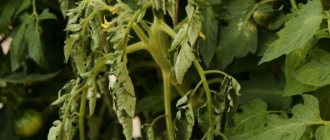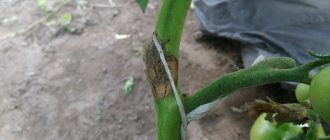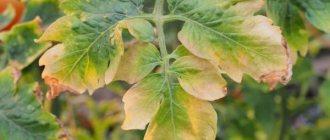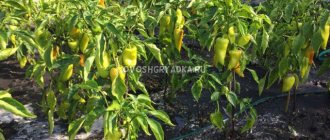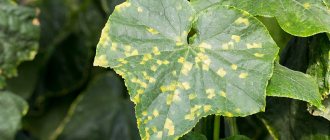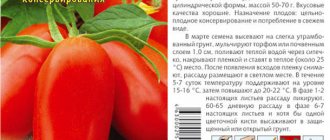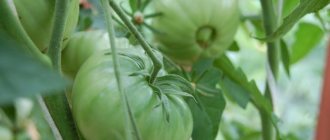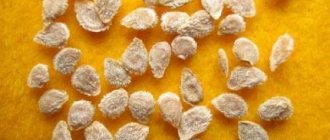What is cladosporiosis of tomatoes?
The description of the disease is simple - a fungal infection. It infects the plant in the lower part, gradually moving to the top. At first, signs of the disease appear only on the leaves, but if the fight is not started in time, it will affect both the stem and the fruits. Conidia, non-motile spores, are lighter than the spores of ordinary mushrooms, so they spread faster.
Cladosporiosis is popularly called brown or olive spot because of the color of the spots.
Did you know? The genus Cladospora belongs to the imperfect fungi. They were able to spread to all six continents and attack not only the plant world, but also people.
Chemicals
If you need something fast-acting and easy to dilute, then you can use the following drugs specifically for brown spot:
- "Bravo";
- "NeoTek";
- "Kaptan";
- "Polychomus";
- "Zineb";
- "Abiga Peak";
- "HOM";
- “Polishing.”
These are effective products and are broad-spectrum fungicides. You should breed them only according to the instructions, so as not to harm the plants and yourself. Two weeks after treatment, it is recommended to repeat all the steps again, since the mushrooms are very tenacious, and many spores may still remain. Never overuse fungicides!
You can also use a solution based on Polycarbacin, copper sulfate and colloidal sulfur. They are mixed in a bucket of water at the rate of a spoon of the first and second components, and three spoons of sulfur. Both seedlings and soil need treatment – once every 5-7 days.
Causes and pathogens
The cause of the disease is the fungus Cladosporium fulvum. Its main feature is to maintain survivability for up to 10 months. It is not afraid of negative temperatures and drought.
Infection occurs when spores land on the bush. They are light as dust, so they can be spread in any way. More often this happens when watering or loosening the soil, when you touched a sick plant with a working tool and then moved to a healthy one.
Therefore, it is necessary to monitor the appearance of tomato bushes. In addition, even if you have overcome the disease, the spores may remain on the tool until the next season, so it is necessary to pay attention to the disinfection of garden tools.
Cladosporiosis: symptoms of the disease.
Cucumber.
Science says that most often it is Cucumbers that suffer from cladosporiosis, regardless of whether they are grown in protected or open ground. The onset of the disease is facilitated by:
- significant (10-20°C) difference between day and night temperatures;
- increased relative humidity;
- watering with cold water;
- drafts.
After 6-7 days of this “severe” regime:
- Round or angular spots appear on the leaves. Their color is light brown or brownish with a yellow border;
- oblong dry sores form on shoots, stems, petioles;
- Small depressed spots appear on the fruits, seemingly oily. As time goes on, they dry out, increase in size, deepen by 2-3 millimeters and may resemble brown-yellow scabs. A glue-like (viscous) brown liquid is often observed between the scabs on the surfaces of the fruit. The fruits themselves usually stop growing and become distorted.
All plant organs, “hit” by the fungus Cladosporium cucumerinum, soon lose their elegant, cheerful green color. Spots and ulcers quickly (especially in humid weather) become covered with a velvety gray-olive coating - these are myriads of young spores. They rush (helpers: wind, tools, insects, equipment, shoes and clothes of the worker, the cool and damp ground layer of the atmosphere) towards neighbors in the garden bed, greenhouse or plantation - and in another week it will be possible to say “Goodbye, harvest!”
The conidia of the pathogen will survive the low-temperature period of the year on ruined fruits, vines, foliage and other plant debris.
Peony.
In the first half of summer, brown, brown or faint purple spots appear on the foliage of the peony bush. At first they are quite large, but over time they continue to grow - to the point that they merge with each other and cover the entire leaf plate. Later they darken, and the leaf looks as if burned. In humid air, its lower side will become dusty with a smoky coating consisting of new spores. (You can call this coating dark gray.)
On young shoots, the spots have a reddish-brown tint and, naturally, an elongated shape. Then almost the entire stem will darken and become covered with the same smoky coating.
The fungus Cladosporium paeoniae will give the buds an unattractive brown color and then shed their petals.
Its conidia will overwinter on fallen leaves.
Tomato.
There are scientists who have declared cladosporiosis one of the most harmful diseases of tomatoes in closed ground - either in film (“spring”) greenhouses or in glass (“winter”) greenhouses. Other experts speak no less convincingly about vulnerability in open ground. Apparently, both groups of arguers are right, if we take into account the meridional extent (from north to south) of the zones in which it has long been customary to grow tomatoes.
Infection can occur on any day from late April to August if the air temperature reaches 22-25°C with a relative humidity of 95% or higher. (It was discovered that if it is reduced to 70-75%, then the development of the disease is inhibited, and at 60% new infections will not occur at all.)
First of all, you need to look at the undersides of the lower leaves - this is where the light green spots will appear. Gradually they acquire a dark brown color with a velvety greenish-brown, olive or gray coating. It is abundant and “tenacious” enough to remain on the skin of the touched fingers. The projections of these spots on the upper sides of the leaves also first have a light green color, then become yellow, and then turn brown. The spots tend to increase in width, merge and thus occupy the entire area of the leaf plate, causing it to dry out and die.
The disease easily “jumps” from lower to higher leaves. If you let it “settle” on more than half of them, you can watch how the whole bush dies. There are signs of cladosporiosis not only on Tomato foliage, but also on petioles, peduncles, flowers, stalks, fruits... This does not happen every year, but, as a rule, during epiphytoties. An attacked young fruit is no longer destined to turn red: it will wrinkle, turn brown, dry out and fall off. You will see an unhealthy spot around the attachment point of the stalk.
Conidia of the fungus Cladosporium fulvum “know how” to maintain their dangerous pathogenic potential for several months - and they survive wintering in a temperate climate zone (and even more so in a subtropical zone) safely, “hiding” in the soil, on the internal surfaces of greenhouses and greenhouses, on pegs and pieces twine used for tying tomato bushes on plant debris.
Signs of infection
Most often, greenhouse tomatoes suffer from the disease, but ground tomatoes are not immune from the attack of cladosporiosis. It appears when the plant begins to bloom.
Signs:
- light green spots without clear contours appear on the lower leaves on the front side;
- the back part of the foliage becomes covered with a light gray coating, over time the color changes to yellow-brown or green-brown;
- diseased foliage gradually dries out and falls off;
- if the disease begins to rise, then round black depressions with a velvety coating may appear on the fruits.
Important! If signs of the disease are noticeable in the upper part of the plant, it means that from below, on the affected leaves, the spores have matured and are ready to be transferred to a new one.
"
master
"
. Therefore, you need to start fighting cladosporiosis as early as possible.
Signs and stages of disease development
The effectiveness of the treatment of tomato cladosporiosis in a greenhouse depends entirely on the timely identification of the disease. This disease, like any other, has several stages of development.
Initial
Only by conducting a careful daily inspection of greenhouse tomatoes is it possible to detect incipient cladosporiosis in time. Small, lightish spots of a yellowish-greenish hue that do not have clear boundaries, appearing on the front part of the lower leaf blades should immediately alert you. But it is not easy to notice them, because they are dim and do not catch the eye. Externally, the tomato bushes look completely healthy. But if you look under the bottom of a suspicious leaf, you will find a characteristic whitish-grayish fungal coating. Most often, primary disorders are detected at the flowering stage of tomatoes.
Progressive
Tomato viral disease is characterized by the formation of darker brown spots in place of light ones. The fungus “rises” higher and higher, infecting other leaves. The plaque on the back of the leaf blades also changes color to rusty-brown. The fungal colony becomes velvety. The spores it produces actively spread and infect neighboring plants.
Progressive stage of tomato cladosporiosis
At this stage, impaired photosynthesis and deterioration in nutrition become noticeable. The disease does not yet affect the filling fruits, but their growth is inhibited. The tomato bushes themselves practically stop developing.
Active
Description and identification of the very last, final stage of cladosporiosis:
- As the disease progresses, the brown spots on the leaves of tomato seedlings darken, turning brown and expanding.
- The spotting is rapidly spreading throughout the above-ground part.
- The foliage curls, loses its shape, turns yellow and dries out, and then falls off.
- The tomato bushes remain bare.
Brown spots of fungus inhabit the stems, and lastly the fruits.
Why is cladosporiosis dangerous?
Affected foliage dries out and falls off. The more leaves a plant loses, the more difficult it will be for it to perform photosynthesis. There will be less nutrients supplied, which means the plant will not have the strength to flower and form the ovary.
In addition, if the ovary was able to form, but the fungus attacked the fruit, it was not destined to ripen. The result is significant crop losses.
How to recognize brown spot on tomatoes
Tomato brown spot develops gradually:
- The first signs can be identified during flowering. The outer part of the lower tomato leaves is covered with light green spots. A light gray coating is observed on the inside of the affected leaves;
- The progressive disease spreads to the upper part of the bush, and all leaves are affected. The stems and fruits remain intact, but they suffer from a lack of nutrients because the leaves are not able to fully support photosynthesis;
- If tomatoes affected by cladosporiosis are started to be treated at the last stage, the prognosis will be disappointing. At this time, irregularly shaped spots change their color from light green to yellow-brown. On the inside of the leaf, the plaque turns brown - this is what mature fungal spores look like. Soon the leaves dry out and curl, and the spores infect new plants.
If brown spotting of tomatoes affects most of the leaves, then after they dry out the bush will die out. The disease rarely affects fruits. Usually only small tomatoes are susceptible to it, which quickly turn brown and wrinkle. On large fruits, convex brown spots are occasionally observed - foci of a new infection, filled with millions of ripened spores.
Methods for controlling and treating cladosporiosis on tomatoes
The fight against the disease is carried out in four ways:
- Chemical.
- People's
- Mechanical.
- Biological.
Read on to find out how to treat and how best to deal with cladosporiosis.
Chemicals
Treatment with chemicals is recommended when it is not possible to save the plant using other means, since chemicals accumulate in the fruits and then enter the human body when eaten.
Important! When working with chemicals, it is necessary to observe all safety measures so that the substance does not come into contact with humans.
A number of fungicides are commonly used to eliminate olive blight:
- “Abiga-Peak” - 50 g per 10 liters of water, treat the plant three times with an interval of 20 days.
- “Bravo” - 3 l per 1 ha (fungicide consumption), 400-600 l per 1 ha (working substance consumption). The first treatment is carried out as a preventive treatment if during the growing season favorable conditions have developed for the manifestation of the fungus. The next two - with an interval of 7-10 days.
- “Poliram” - consumption 6 liters per 1 ha. Three sprays should be carried out. The first - with the beginning of flowering, the second - before the formation of the ovary, the third - between them.
- "Hom" - 40 g per 10 l. When spraying, you need to spend 10 liters per hundred square meters. Treatment is carried out during the growing season. During the period you need to carry out 4 treatments.
Folk remedies
They help little in the fight against olive spot. They are used when the disease has just begun to manifest itself.
The following recipes for fungal remedies are popular:
- Iodine chloride. 0.03 kg of potassium chloride is diluted in a bucket of water and 40 drops of iodine are added. The bush is watered with a solution and sprayed. The soil must be wet by 0.1 m.
- Serum. 1000 ml of product is diluted in 10 liters of water. The mixture is thoroughly mixed and poured under the bush.
- Whey and iodine. 25 drops of iodine are added to a liter of serum. The mixture is diluted with water up to 10 liters. Plants are sprayed with it.
- Potassium permanganate. Water is mixed with potassium permanganate until it turns pink. There should be no solid particles left in the solution. Used for spraying crops.
- Wood ash. A glass of sifted ash is filled with a liter of water, boiled for 30 minutes, cooled and used for spraying and watering bushes.
It will also be useful for you to learn how to get rid of caterpillars on tomatoes and why the leaves on tomatoes turn yellow.
Mechanically
This method involves trimming affected foliage, regularly ventilating greenhouses and increasing the interval between plant irrigation (up to 7 days). To eliminate the possibility of spores spreading, the soil is covered with dark plastic film.
The foliage is removed carefully. The process involves using a plastic bag to cover the diseased foliage and then tearing it into the bag.
Biological method
Biological products, unlike chemicals, are not able to penetrate into the fetus and accumulate in it, but they have a less aggressive effect on pathogens. They are easily washed off when watering or during rain, so treatment must be carried out while being sure that no more precipitation is expected.
- "Fitolavin 300". The product is diluted in an amount of 20 ml per bucket of water. When spraying, 2 liters of product should be used per bush. Treatment is carried out twice, with an interval of 14 days, when the manifestation of the disease is only noted.
- "Fitosporin". 5 grams of powder are diluted in a bucket of water. The foliage is sprayed two to three times at intervals of one and a half to two weeks. The drug is also suitable for treating greenhouses and soil.
- "Pseudobacterin-2". 10 liters are consumed per 1 ha. It is applied twice during the growth period with an interval of 20 days.
Important! Some experts believe that the ideal control option would be to remove the diseased bush and burn it so that the spores do not spread throughout the entire area.
What preventive measures will help avoid the occurrence and development of cladosporiosis?
The formation of brown marks on tomato leaves can be prevented. There are several effective preventative measures.
Seed disinfection
There are frequent cases of fungal infection being introduced into a greenhouse with infected seedling material. To prevent this, it is necessary to treat the seeds before sowing in disinfectants:
- in a light pink (1%) solution of potassium permanganate - soak for half an hour;
- in a heated solution (+40...+45 °C) of hydrogen peroxide (3%) - 7-10 minutes;
- in a fungicide diluted according to instructions (Trichodermin, Fitosporin, Rizoplan, etc.).
Disinfection of tomato seeds
Hydrothermal treatment shows good results. The seeds wrapped in a cloth are immersed in hot water (+48...+50 °C) for 20 minutes, then they are cooled, washed in cold water for 3-4 minutes. Some of the grains will die, but the remaining ones will be healthy and viable.
Soil treatment
Simultaneously with spraying the above-ground vegetative mass of tomatoes with antifungal drugs, it is necessary to treat the soil under the bushes. After all, a huge number of spores get there, which, when the opportunity arises, inevitably become more active. If there are still plants in the greenhouse, it is better to use biofungicidal agents.
At the end of the summer season, when the entire harvest has been harvested, the land will need to be processed more radically:
- Bordeaux mixture (2-3%);
- copper sulfate (up to 4%);
- one of the chemical fungicides.
You can also treat the soil from the cladosporiosis fungus with ordinary boiling water, pouring it generously over the beds. It is recommended to do this twice: late autumn and spring, about two weeks before planting tomato seedlings.
Selecting a tomato variety that is resistant to the disease
Brown spots on tomato leaves caused by cladosporiosis may not appear at all if you select varieties that have good resistance to this disease.
According to the experience of many summer residents, confirmed by numerous reviews, tomatoes that are not genetically prone to cladosporiosis include:
- "Spartacus";
- "Charisma";
- "Opera";
- "Pink Paradise";
- "Doll Masha";
- "Marissa"
- "Delicacy";
- "Bohemia";
- "Vezha";
- "Martin";
- "Giant";
- "Funtik";
- "Business lady";
- "Pink Magic";
- "Evpator" and others.
A thoughtful choice of planting material is especially important if an infection was detected in the previous season. Before purchasing, it is recommended to carefully study the varietal descriptions of tomatoes.
Preventive measures
Olive spot is one of the diseases that is cheaper to prevent than to fight.
We recommend the following as preventive measures:
- frequently ventilate the greenhouse;
- remove diseased foliage from the bottom of the bush in a timely manner;
- disinfection of the greenhouse and soil at the beginning and end of the season;
- clearing the bed of crop residues and burning them;
- keep the humidity in the greenhouse at 60-70%, and the temperature at +18...+20 °C;
- daily inspection of plants;
- planting seedlings strictly according to the scheme;
- disinfect seeds;
- do not allow the soil to become soaked;
- watering bushes only early in the morning or late in the evening;
- periodic treatment of plants with biological preparations.
Fusarium disease - description
Fusarium disease affects the vascular system of plants, causing Fusarium wilt. Fungi also act on tissue, causing rotting of roots, fruits and seeds. When plants wilt, they die from blockage of blood vessels with fungal mycelium and its toxic secretions, resulting in disruption of vital functions. Affected specimens bloom poorly, their leaves turn yellow and fall off, the root system stops developing and darkens, and darkened vessels can be seen on the stem cut.
The disease begins with root rot: the infection penetrates from the soil through small roots, and then enters large roots, after which it rises through the drainage vessels along the stems to the leaves. First, the leaves of the lower tier wither, the edges of the rest become watery, and yellow and light green spots appear on the plates. The vessels of the petioles weaken, and the leaves hang along the stem like rags. In conditions of high air humidity, a thin white coating appears on the leaf plates. The disease progresses with sharp fluctuations in temperature and humidity, as well as against the background of insufficient soil nutrition.
Factors that contribute to the activation of fusarium pathogens:
- weakening of the plant due to poor care or improper maintenance conditions;
- too dense planting;
- acidic soil, heavy soil, stagnation of moisture in the soil, preventing air access to plant roots, planting plants in low-lying areas;
- excessive application of chemicals to the soil, including fertilizers containing chlorine;
- placing the planting close to an industrial zone, especially to metallurgical enterprises, or to a highway;
- dry roots due to insufficient watering;
- high humidity and high temperature.
Tomato varieties resistant to cladosporiosis
Breeders have managed to develop varieties resistant to cladosporiosis:
- Our Masha F1;
- Space Star F1;
- Vezha;
- Giant;
- Pink Paradise F1;
- Vitador F1;
- Swallow F1;
- Pinky F1;
- Business Lady F1;
- Pink Magic F1;
- Paradisaic delight;
- Malika F1;
- Black Moor;
- Cherry Ira F1;
- Admiralteyskiy;
- Red cherry;
- Titanic F1;
- Gardener;
- Red Comet F1;
- Victoria F1;
- Torbay F1;
- Centaur F1;
- Octopus F1;
- Delicacy
- Funtik;
- Evpator.
Olive spot of tomatoes can cause a lot of trouble for agronomists and reduce yields.
Did you know? Wild tomatoes grow in South America. They produce fruits weighing 1 gram.
The fight against the disease must begin when the first symptoms are detected. But it is better to take preventive measures to avoid such problems.
Prevention measures
What means do you use to fight fungus?
ChemicalFolk
Compliance with the rules of agricultural technology helps prevent infection of plants by fungus and prevent its proliferation.
Compliance with the following rules will help solve this problem:
- Disinfecting seed treatment. To do this, they are placed in a weak solution of potassium permanganate at a temperature of 40–50 degrees for 30 minutes.
- Maintaining moderate humidity in the greenhouse and under temporary shelters.
- Compliance with watering norms and rules. Only warm water is used. Watering is carried out at the root, avoiding drops falling on the leaves.
- Cleaning and disposal of plant residues at the end of the growing season.
- Timely mulching of the soil around plants. It is better to use hay or mown grass as mulch: useful hay bacillus develops under them. Prevents the proliferation of pathogenic microorganisms.
- Providing ventilation for the above-ground parts of plants. To ensure that the bush is well ventilated, carefully remove the lower leaves, especially those in contact with the soil.
- Carrying out preventive spraying with copper-containing preparations or folk remedies.
- Regular disinfection of gardening equipment.
- Maintaining crop rotation. It is not recommended to grow the same crop in one area for more than 3 years, so that characteristic pathogens do not accumulate in the soil.
- Selection of disease-resistant varieties and hybrids. Cucumbers that successfully resist fungal infection are: Adam, Cupid, Cornflower, Hector; tomatoes: Charisma, Opera, Bohemia, Olya, Titanic. Fast and Furious; pepper: Actor, Tomboy, Nafanya.
- Strengthening plant immunity with the help of timely fertilizing and treatment with Immunocytofit, Zircon, Novosil.
- Soil improvement. Before sowing and planting plants, the soil is watered with solutions of the preparations Trichodermin, Fitosporin, Baktofit, Alirin, Baikal M - 1.
Trichodermin
Baktofit
Alirin
Baikal M1
Expert opinion
Chernyaeva Tatyana Dmitrievna
Absolutely loves gardening and grows only organic vegetables
Ask a Question
The solarization procedure helps destroy fungus accumulated in the soil. In summer, the infected area is covered with plastic wrap for 6 to 8 weeks. Exposure to UV rays and bright light with an intensity of more than 23,000 lux is detrimental to the pathogen.
Cladosporiosis is not a very aggressive disease and with timely measures it is not difficult to defeat it. If the case is advanced and the spores have affected a large area, treatment requires patience and an integrated approach.
Advice from gardeners
- Do not thicken the planting of tomatoes in the greenhouse. Form plants into one stem.
- Disinfect the frame and inner surface of the greenhouse with Bordeaux mixture or copper sulfate.
- Freeze the soil in the greenhouse in winter. To do this, open the doors and remove the side walls, if possible.
- Once a year, disinfect the greenhouse using a sulfur bomb.
- Grow only genetically resistant tomato varieties.
- Use biological products at all stages of cultivation, starting from seeds.
Cladosporiosis is not easy to get rid of. But if you use the entire arsenal of available means and measures, you can restrain its development and grow a full-fledged harvest. The most important thing is prevention and early diagnosis.
Other most dangerous tomato diseases
In addition to cladosporiosis, you should be aware of several other infections that threaten yield loss for tomatoes.
Late blight
The causative agent is the parasitic fungus Phytophthora. A very aggressive disease. Under favorable development conditions, even infection-resistant varieties are affected. The catalyst for the spread is high humidity, cold nights with dew, and temperature changes. Attacks plants with weakened immunity and damage.
It affects all parts of the plant and rapidly gains strength, starting with the stem, which darkens, then the leaves become covered with brown spots and finally the fruits are affected. To combat late blight, traditional methods, chemistry and biological products are also used. Fitosporin is well suited for prevention.
Alternaria blight
In other words, dry spotting. An equally dangerous fungal disease can destroy almost the entire crop. The favorable climate for it is dry and warm weather. Plants can get sick both indoors and outdoors. It also starts from the lower leaves, forming round brown spots on them, then the stem begins to rot. The fruits are the last to become infected; they develop depressed dark areas near the stalk.
Note! The disease responds well to treatment with drugs containing copper. If the plants have begun to bear fruit, they can only be treated with biological products.
The best method of combating diseases is prevention. During the period of active growth of plantings, in the midst of summer, you need to carefully monitor the level of humidity in the greenhouse and maintain an optimal temperature, regularly ventilate, water the bushes strictly at the root, cover the ground with paper or straw mulch if necessary.
